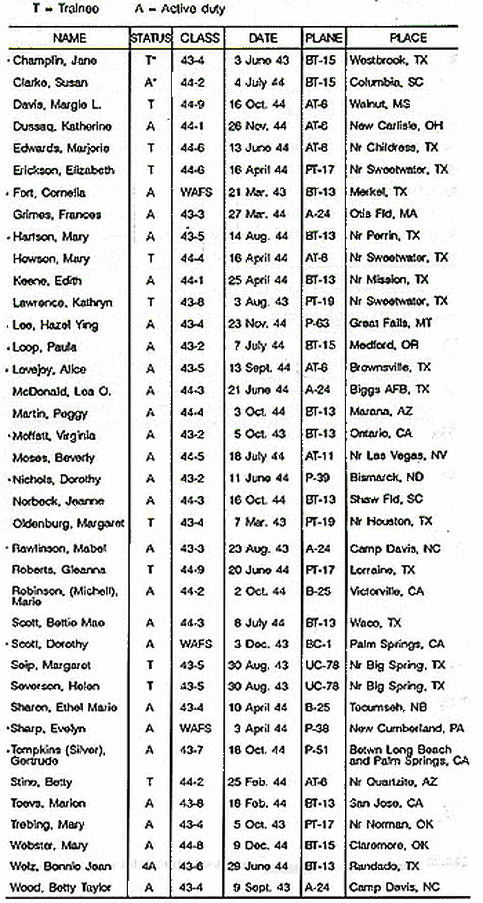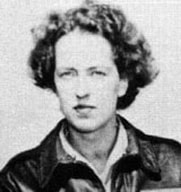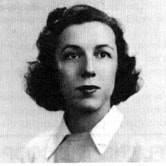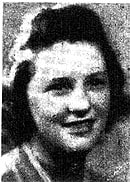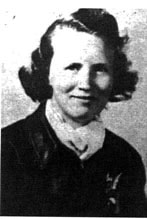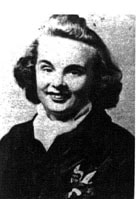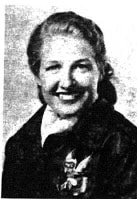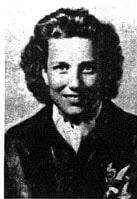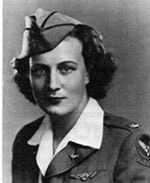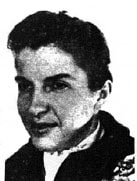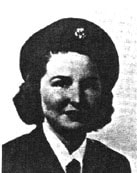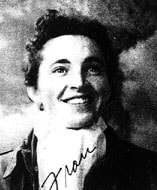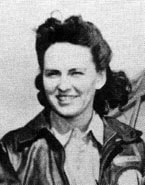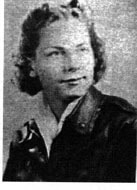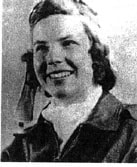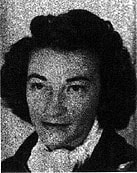Women Airforce Service Pilots
Killed in Service (Part 1)
Killed in Service (Part 1)
(Part 1 - March 7, 1943 to April 25, 1944)
Page available since 10/26/97 - last updated 4/26/2023
Thirty-eight women pilots sacrificed their lives in support of WWII.
|
The above table was taken from appendix Q of "On Final Approach" by Byrd Howell Granger, Class of 43-1. This book also provided much of the information presented below. Please note that some of the dates shown in the table are incorrect.
|
The following information and the information in Part 2 provides a little more on the life and death of the of these courageous women.
|
Margaret Sanford [Oldenburg]
July 29, 1909 to March 7, 1943 The weather in Houston had been terrible and the planes were grounded. When the weather cleared, the students from 43-4 were eager to practice spins in the PT-19s. But something went wrong with one of the flights and Margaret and her instructor dove straight into the ground. The training command ordered that the accident be kept quiet. Since these women were not considered as military at the time, they were not entitled to burial expenses or survivor's benefits. Jacquelin Cochran took care of all the expenses and Mrs. Deaton escorts Margaret's body home. Margaret was a 1931 graduate of the University of California at Berkeley. She took up flying in 1933 after meeting Amelia Earhart. |
|
Cornelia Fort
February 5, 1919 to March 21, 1943 - On this beautiful day over Texas, Cornelia, with over 1,100 flight hours, and six male pilots, fresh from 90 days of training, were ferrying some new BT-13s to Dallas Love field. During this flight, they flew in close formation, which was not allowed during ferrying missions, for a portion of the trip. At some point after most had returned to safer distances, the plane flown by Frank E. Stamme, who had 267 flight hours, collided with Cornelia's plane. His landing gear and the tip of Cornelia's left wing crashed together. The tip of the wing broke away along with six feet of the leading edge. Her plane eventually hit the ground in a vertical position. The engine went two feet into the ground. Cornelia was only 25 years old. Cornelia was flying as an instructor in Hawaii on December 7, 1941. She was nearly knocked out of the sky by a Zero. (There is a scene in the movie "Tora Tora Tora" that recounts this.) After landing the plane she escaped being shot as another Zero strafed the field. In September of 1942 she received an invitation to try out for the Air Transport Command. She was the second women to check in. She had 845 flight hours and most of that was as an instructor. Later she was joined by 27 other women who became known as the Women's Auxiliary Ferrying Squadron. A tribute from her nephew, Dudley Fort. Another tribute Crash site with marker |
|
Jane Dolores Champlin
May 14, 1917 to June 3, 1943 - Jane was born in Chicago and grew up in Richmond, Virginia. She graduated from Arcadia College and St. Louis University with a B.A. in 1937. She was the first alumni to die in WW II and a building on the campus is named in her honor. She was interested in horseback riding, diving, tennis, and of course flying. She learned to fly in 1940 while in St. Louis and got her pilot's license in the Civil Air Patrol Jane heard about Jacqueline Cochran's WASP recruitment effort while living in St. Louis where she was working for the Railway Express Agency. She promptly quit her job and took up flying almost full time to get the required hours and used up all her savings for two nose operations to correct a sinus and breathing problem. She was able to pass the AAF physical and was in training at Sweetwater when she lost her life. She and her baymate Jennie Hrestu were practicing night flying in BT-13s with their respective instructors. Jennie got back to the barracks around 1:00 AM and fell sound asleep. When she awoke later that morning Jane's bunk was still empty. This was the first fatal crash at Avenger Field in Sweetwater, Texas. |
|
Kathryn Barbara Lawrence
December 3, 1920 to August 4, 1943 While working on her B. S. in Education at the University of North Dakota she enrolled in the Civil Pilot Program (CPT) and was the first women to finish the course and earn her pilot license. She worked for the Boeing Aircraft Company until July 5, 1943, when she joined the WASP. She died while flying solo in a PT-19. Kay Lawrence was finally given official recognition for her service to her country. On October 14, 2006, "The air was cool and crisp, and the sun filtered through trees that have lost their leaves. The gun salute was heard and taps sounded throughout the cemetery. " |
|
Mabel Virginia Rawlinson
March 19, 1917 to August 23, 1943 - After completing her basic training, Mabel Rawlinson , a professional secretary for Flora Roberts at the Kalamazoo Public Library (KPL) and singer in the church choir, reported to Camp Davis Army Air Field in North Carolina. Here she was to support anti aircraft artillery training by towing targets behind A24s. She first received additional training for the A24s including night flying. One night, shortly after takeoff the plane developed mechanical problems and she and her instructor had to return. While coming in on final approach, the landing gear of her A24 hit the tops of the tall sea pines that surrounded the field. The plane nosed down, hit the ground, and split in two. The instructor in the backseat was thrown clear. Mabel was trapped in the front of the plane as it went up in flames ... the canopy release for her cockpit was known not to function from the inside - she was trapped. Here is a summary of the Army Air Force accident report. The A-24s they were using for tow target training at Camp Davis were worn out from war duty, not well maintained due to lack of parts, and they were using lower octane fuel, 90 vs. 100, than required. Fifteen of the 37 tow target accidents involved the A-24 and 14 of the 37 occurred at Camp Davis. The first 10 accidents at Camp Davis were in A-24s and occurred between 8/6/43 to 11/18/43. Here is what Mary Creason, her sister, remembers about her sister Mabel. Also, her niece has created a very detailed biography |
|
Margaret June "Peggy" Seip
June 24, 1916 to August 30, 1943 - Peggy and Helen Severson were only 11 days away from graduation and were thinking about their next assignment as Air Transport Command ferrying pilots. They were with their instructor in an UC-78 on a flight from Sweetwater to Big Springs to practice radio navigation. Helen was flying under the hood at the time of the accident. An accident investigation blamed the crash on structural failure. Later that evening, some of their classmates gathered around a vine that Margaret and Helen had planted in March. It now covered the rear wall of a barracks. Peggy was born in Milwaukee, Wisconsin. Margaret graduated from Sarah Lawrence in 1938, a year before Cornelia Fort, with a B.S. in English. She was a member of Kappa Alpha Theta and Tau Kappa Alpha. Peggy acquired her private pilot license in the fall of 1940. She was on of the first women to join the Wisconsin CAP. In the fall of 1942 she and Cornelia enrolled at the Link Instructors Training School in upstate New York. She was a Link Instructor for army pilots before she joined the WASPs in March, 1943. |
|
Helen Jo Anderson Severson
November 2, 1918 to August 30, 1943 - Helen and Peggy Seip were only 11 days away from graduation and were thinking about their next assignment as Air Transport Command ferrying pilots. They were with their instructor in an AT-17 on a flight from Sweetwater to Big Springs to practice radio navigation. Helen was flying under the hood at the time of the accident. An accident investigation blamed the crash on structural failure. Later that evening, some of their classmates gathered around a vine that Margaret and Helen had planted in March. It now covered the rear wall of a barracks. Helen was born in Marvin, South Dakota. She graduated from Summit High School as the 1936 class valedictorian. She got her B.A with honors in Political Science from South Dakota University. Helen had received her Masters Degree in Library Science from University of Illinois and learned to fly in her spare time. At South Dakota State University, she completed Civilian Pilot Training. She managed the Urbana Municipal Airport and became a member of the CAP. Helen was married to a pilot, Capt. Robert Severson, who was shot down over Germany. Robert had volunteered for this mission after the death of Helen Jo. |
|
Betty L. Taylor [Wood]
March 1921 to September 23, 1943 Betty went from basic training in Sweetwater to Camp Davis for tow target training. During a landing with the camp's Chaplin on board as a passenger, the left wing tip hit the runway turned to the left. She had to abort the landing and give the A-24 full throttle to go around for another try. However, the plane hit a 4 foot high embankment went into a stall and then rolled and went into the ground upside down. Both Betty and the chaplin were crushed between the canopy and plane. One explanation was that the throttle was 'sticky' and this caused a late, sudden surge of power that torqued the aircraft over. This combined with Betty's pulling up on the stick pushed the A-24 into the ground. The A-24s they were using for tow target training at Camp Davis were worn out from war duty, not well maintained due to lack of parts, and they were using lower octane fuel, 90 vs. 100, than required. Fifteen of the 37 tow target accidents involved the A-24 and 14 of the 37 occurred at Camp Davis. The first 10 accidents at Camp Davis were in A-24s and occurred between 8/6/43 to 11/18/43. This was the second death in the last 31 days at Camp Davis in an A-24. Betty was living in Auburn California when she joined the WASP, but was born in New Berlin, Illinois. She married a WASP instructor, "Shorty" Wood, on the same say she graduated from WASP basic training. |
|
Virginia C. Moffatt
May 31, 1912 to October 5, 1943 - Virginia started flying in 1942 and graduated with class 43-2 at the end of May in 1943. She reported to the 6th Ferrying Group at Long Beach Army Air Base in California. Here, at the end of a stressful day of ferrying BT-13s, she spun in on final approach at Ontario Field. Virginia was born in Wheatland, Wyoming and moved to LA with her mother and four sisters after her father died in the cavalry. |
|
Mary Elizabeth Trebing ??? to November 7, 1943 - Mary reported to Love Field in Dallas, TX, after completing basic training. She was killed after buzzing a farm house. She was unable to pull up before hitting some nearby power lines. Mary was born in Louisville, Colorado, then her family moved to Wilburn, Oklahoma. There she graduated from Eastern Oklahoma A&M College and learned to fly at the local Winson Cocke Airport. As remembered by her brother , Bill Treging. |
|
Dorothy F. Scott February 16, 1920 to December 3, 1943 - Dorothy was one of the original WAFs. She started out at New Castle Army Air Base in Wilimington Delaware and then went to the 5th Ferrying Group at Love Field in Dallas. While stationed at Love, she was sent to Palm Springs Army Air Field for pursuit plane training for the P-39, P-40, and P-47. Initial training started from the rear seat of an AT-6 or BC-1, which simulated the view from a pursuit plane cockpit. On this fateful day, there were several trainers and pursuits in the air. Dorothy had just been cleared to make her final landing. The tower had also cleared a P-39 to come in second. However, one thing had not been taken into account during this landing of both planes: the P-39 was the faster of the two. Without even seeing the BC-1, the P-39 caught up with it and came down on it without ever seeing it. Dorothy and her twin brother grew up and went to school in Oroville, Washington. While going to the University of Washington, Dorothy learned to fly float planes on Lake Union. Her father was learning to fly at the same time, but Dorothy soloed first. Later while in the WASP, her picture appeared in Look Magazine . |
|
Marian J. Toevs May 13, 1917 to February 18, 1944 After graduating on December 17, 1943, from basic training, Marion reported to Lemoore Army Air Base in California. She was only one of two WASPs sent there for BT-15 engineering/test flying. On a routine flight from Lemoore to Fresno in a BT-13, she crashed. Marian was born and raised in Aberdeen, Idaho. She learned to fly while attending Eastern Washington State College. She had two older and two younger brothers. |
|
Betty Pauline Stine ??? to February 25, 1944 The investigating report stated that sparks from the engine exhaust had set fire to the tail of the plane. Just before the plane crashed into a mountain, Betty was spotted by a miner coming down in her parachute. It wasn't until later that the miner and two others reached Betty. She had been dragged across the rocky terrain by the strong winds and was is very bad shape. She was taken to the base hospital at Blyth where she died. Very shortly after Betty's death, a parachute training system was built at Avenger field and twelve hours of instruction were added to basic training. Betty was born in Fort Worth but grew up in Santa Barbara, California. She attend the public schools and state college for two years and then transferred to the University of Arizona. However, she returned to Fort Worth Municipal Airport of flight training before joining the WASP. She was an only child and was the great niece of humorist Will Rogers. She was named after his wife. |
|
Frances Fortune Grimes ???, 1911/12 to March 27, 1944 - During basic training in Houston, she lost her two front teeth after running into Margaret Cook during a baseball game. Initially, Frances reported to Love Field, Dallas, Texas. Later she was transferred to Camp Davis, N.C. She lost her life in an A-24 Dive Bomber shortly after take off near Otis Field, Massachusetts. Frances was born in Deer Park, Maryland, but grew up with her two sisters in West Virginia. She was quite an athlete. She received the Governor's Award as West Virginia's outstanding athlete. She excelled at both tennis and golf. She later became a CPT instructor and member of the CAP before joining the WASP. Memorial Day observance at Otis Memorial Park to include ceremony honoring Frances Fortune Grimes |
|
Evelyn Sharp October 1, 1919 to April 3, 1944 Evelyn was one of the original WAFS with almost 3,000 hours of flying time when she joined and was assigned to New Castle Army Air Base in Wilmington, Delaware. She spent some time in Palm Springs and Long Beach, California. It was in a twin engine P-38, that she lost her life. A short bio. Here's a memorial video about her. One minute after take-off and with 700 feet altitude, one of the engines failed. For many pilots, the remaining engine would have torqued the plane over and into the ground. But Evelyn jammed the rudder to counter the effect, turned the plane back toward the field and pancaked the P-38 for a wheels up landing. The plane was not badly damaged, but Evelyn's neck was broken. Evelyn was born in Melstone, Montana. In 1930, the family moved to Ord, Nebraska. She began flying at age 14, got a private license at 17, and her commercial license at 17. She taught over 350 men and women to fly. During the depression, some Ord businessmen provided the down payment for her Taylor Cub. She paid for the plane by barnstorming and giving plane rides to over 5,000 passengers. While at New Castle she delivered over 150 planes of 18 different types. During her funeral, the mayor of Ord announced that the local airport would hence be named Evelyn Sharp Field. |
|
Marie Ethel Sharon April 21, 1917 to April 10, 1944 After graduation from basic training, Marie reported to the 6th Ferrying Group at Long Beach Army Air Base. Later she would spend time in Nebraska getting training in the B-25 bomber, including instrument flying. Even though it was April, a heavy blizzard was forecast. Marie, her instructor, and a sergeant prepare the B-25 for flight and her final phase of instrumentation flying. During the flight they met up with the blizzard and never returned. Marie was born in Foresythe, Montana, but finally settled in Portland, Oregon. Before joining the WASP she worked as a fashion designer. |
|
Jayne Elizabeth Erickson April 14, 1921 to April 16, 1944 Elizabeth, class 44-6, and Mary Howson , class 44-4, were both training on this final day of their lives. Elizabeth is just about to complete her first solo in an AT-6 and is also planing to land. Mary had been on a long cross-country flight in a AT-6 and was preparing to land at Avenger Field. They are approaching Avenger Field from different directions and they are on a collision course. Elizabeth is busy getting ready to do practice landing. Mary is looking into the Sun. They collide. Elizabeth fell to the ground in her plane. Mary bailed out but was too low for her parachute to open. Elizabeth was born in Seattle and the eldest of three. The family moved to Preston, Washington, where she completed high school with honors and as a class officer. She was outgoing, became a cheerleader, edited the school yearbook, made the honor roll, participated in band and choir, and was a class officer. She attended the University of Washington where she majored in art. She was in the tri deltas and worked full time in the summer and part time during school at a bank. At the bank she met Don Smith and the became engaged. When war broke out, she moved to Yakima, Washington, learned to fly, and joined the WASP. |
|
Mary Holmes Howson February 16, 1919 to April 16, 1944 Mary Howson , class 44-4, and Elizabeth, class 44-6, were both training on this final day of their lives. Mary had been on a long cross-country flight in a AT-6 and was preparing to land at Avenger Field. Elizabeth is just about to complete her first solo in an AT-6 and is also planing to land. They are approaching Avenger Field from different directions and they are on a collision course. Elizabeth is busy getting ready to do practice landing. Mary is looking into the Sun. They collide. Elizabeth fell to the ground in her plane. Mary bailed out but was too low for her parachute to open. Mary was borne in Wayne, Pennsylvania, and had two brothers that were already in the service. She majored in art at Smith College. Mary became a teacher at Booth School in Devon, PA., after getting a teaching fellowship at Oak Lane Country Day Scholland and studying at UCLA. After teaching for a term, she also studied at Bryn Mawr in aerial mapping. Just before joining the WASP, she was working for the U. S. Geological Survey Office in Washington, D.C. and spent every spare moment learning navigation and practicing flying at a nearby field. A tribute from James Whitcomb Riley, and book plate. |
|
Edith "Edy" Clayton Keene December 19, 1920 to April 25, 1944 After graduation from WASP basic on February 11. 1944, Edith reported to Hondo Army Air Field in Hondo, Texas, where she piloted twin engine aircraft to train student navigators. From there she went to Moore Army Air Base in Mission, Texas. On an almost perfect afternoon for flying, Edith was passenger in an AT-6. The pilot was putting the plane through standard flight manoeuvres including barrel rolls and loops. While trying to pull out of a dive, a portion of one wing was torn loose. The plane spun out of control. The pilot ejected to safety, but Edith was pinned in the rear cockpit and unable to get out. Edith was born in Canton, Montana but spent most of her life in California. She had four sisters. She received her pilots license at Pomona Airport. She was one of five women in the CPT program before she joined the WASP. As of December, 2001, she was survived by her sisters, Winona, Frances, Edwina, and Hope. Her mother lived to the age of 110 and just recently passed away. (My thanks to Audrey Haworth, the grand-niece of Edith.) |
See Part 2 for more on the life and death of the of the other 19 courageous women.



